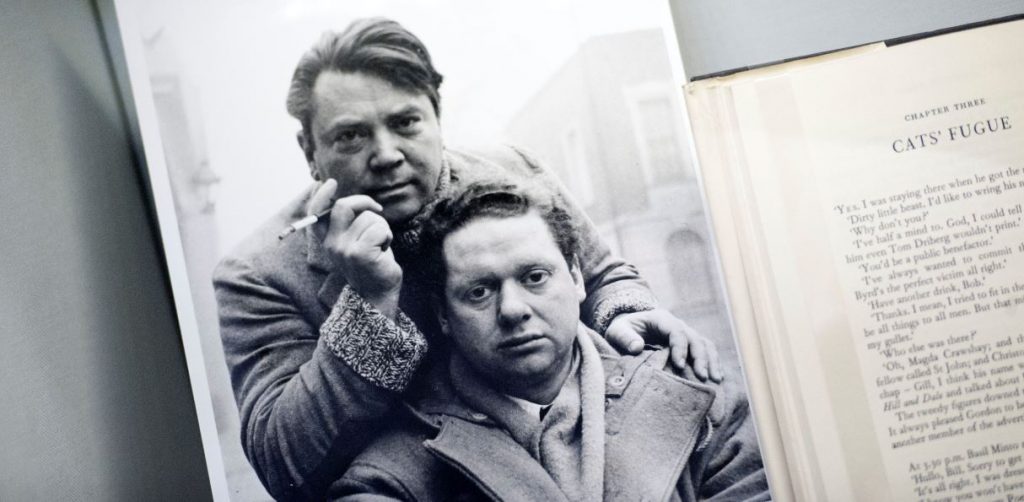The Death of the King’s Canary


‘Leave the tortoise alone, Mrs Porter. He’s not dead. He’s thinking.’
-The Death of the King’s Canary by Dylan Thomas and John Davenport
At last! I have finally read Dylan’s novel (co-written with John Davenport) The Death of the King’s Canary. When he first came up with the idea, Dylan’s intention was that it would be ‘the detective story to end detective stories’ and that it would ‘drag hundreds of red herrings, false clues, withheld evidences into the story, falsify every issue, make many chapters deliberate parodies, full of clichés, of other detective- writers.’ (Dylan Thomas’ Collected Letters p. 323) I’m a huge crime fiction fan and I love Dylan Thomas’ stories so, to me, this book promised to be the perfect combination.
Desmond Hawkins was Dylan’s first collaborator on the project and in a letter dated 16th September 1935, Dylan requests that Hawkins sends him the list of character names they had compiled, and work by Stephen Spender (presumably so he could begin his parodies of it.) Somewhen between 1st November 1935 (when Dylan tells Hawkins he is going to re-write what he’s done) and March 16th 1938, his Swansea friend Charles Fisher takes over the mantle of co-author. Dylan writes to Fisher ‘It could be the best fun, & would make us drinking-money for a year.’
However, Fisher was called up to fight in the War (he was an operative for British Intelligence and took part in active service in France) and thus John Davenport, as Dylan writes to Vernon Watkins on 8th January 1941, became the new collaborator for the ‘fantastic thriller’. Although finished in 1941, Dylan borrowing Vernon Watkins typewriter to type up the last sections, it wasn’t published until 1976. This was possibly due to it containing many, thinly disguised, parodies of contemporary poets and cultural figures, including T.S. Eliot, W.H. Auden, George Barker and the Sitwells. In his introduction to the novel, Constantine Fitzgibbon argues that it was ‘quite unpublishable while the main characters were alive’.
At the beginning of the novel the Prime Minister is tasked with choosing the next Poet Laureate. After reading the poems of several candidates (all pastiches of living poets) he finally settles on Hilary Byrd. The announcement sends horror through the cultural community, their reactions often reading as individual comedy sketches. The action culminates in a house party, thrown by Byrd to celebrate his appointment, and it is there that the new Laureate (known as the King’s Canary) meets his grizzly end.
Although this wasn’t the detective story I imagined it would be, the parodies being of people rather than of crime stories per se, there were certainly parts that made me chuckle. It definitely made me curious to read more of the work of Stephen Spencer and William Empson, whose work Dylan satirised in the poems ‘The Parachutist’ and ‘Request to Leda’ respectively. ‘The Parachutist’ was apparently so on point, when Dylan read it at a talk he was giving in Oxford, it ‘had people rolling on the floor’ (Philip Larkin quoted in Dylan Thomas: A New Life by Andrew Lycett, p.230)
Despite some of the insider humour being a little lost on me, I thoroughly enjoyed reading The Death of the King’s Canary. Trying to spot which bits were written by Dylan and which bits by John Davenport added an additional ‘who dunnit’ dimension to the experience! My favourite character- although I’m not sure who she was based on- was Mrs Crawshaw. She is described as a woman who ‘had been knocked about in a good many stormy seas, but she’d kept her yachtish lines’. When she is spotted walking naked along the parapet of Dymmock Hall with an open umbrella, the house’s occupants rush to her aid. Wondering what the fuss is about, she demands a parasol and a brandy-and-soda!
Katie Bowman, Dylan Thomas Centre
This post is also available in: Welsh


